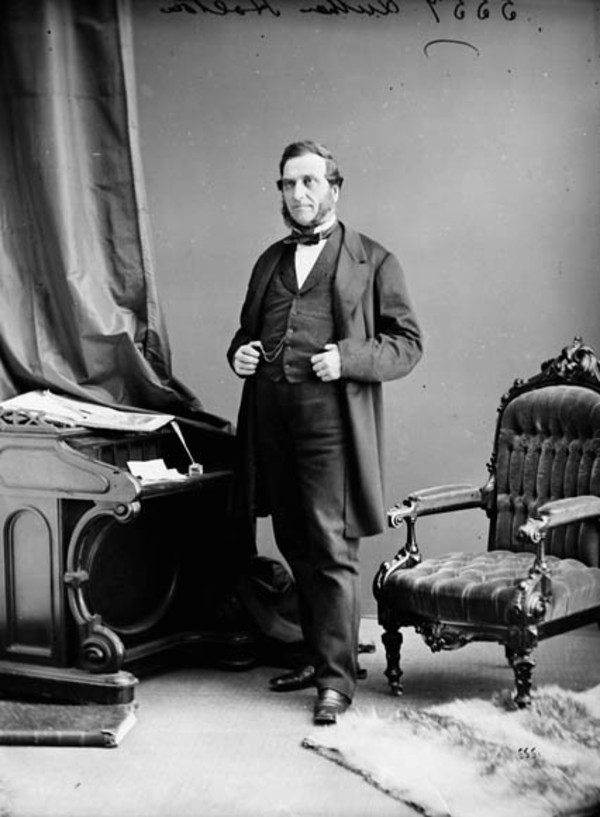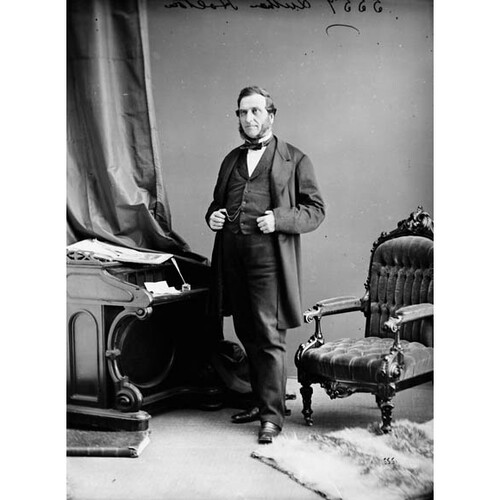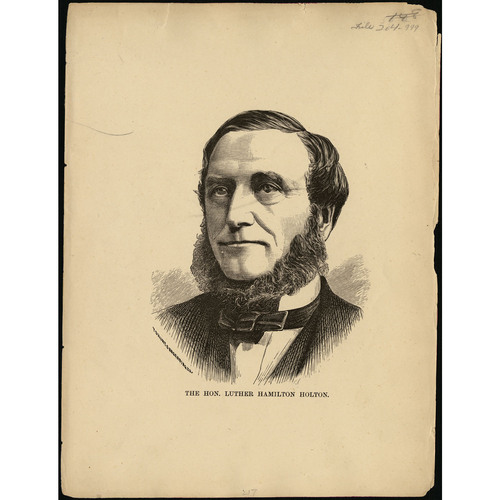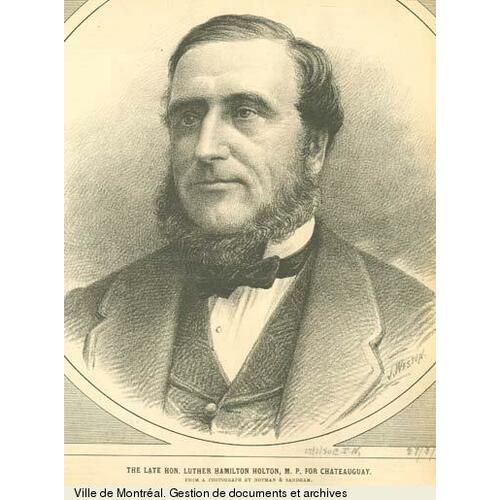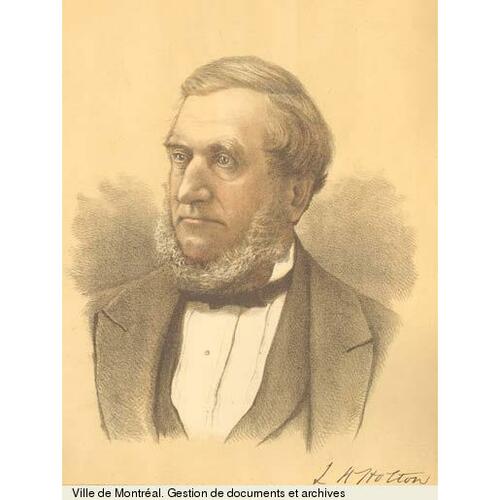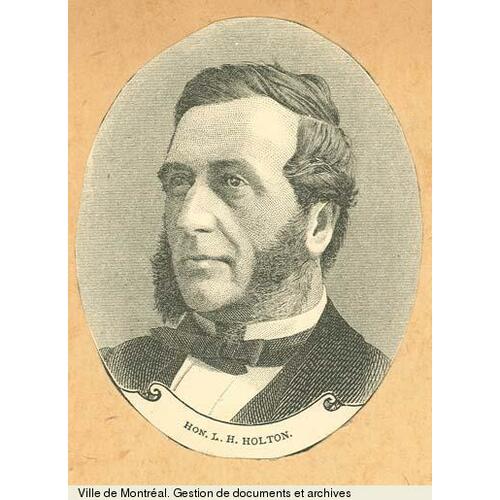HOLTON, LUTHER HAMILTON, Montreal businessman, civic leader, and politician; b. 22 Jan. 1817 at Sheffield’s Corners (now Soperton), Leeds County, U.C., the second son and fourth child of six children of Ezra Holton and Anner Phillips, who had migrated from Brandon, Vermont, to Sheffield’s Corners in 1811; d. 14 March 1880 in Ottawa, Ont., and was buried in Mount Royal Cemetery, Montreal, Que.
When Luther Hamilton Holton was seven years old, his father, a poor farmer, died, and in 1826 he went to Montreal to live with his uncle, Moses Gilbert, a Vermont-born general merchant, who enrolled him in the Union School. A bright and determined student, he remained in this private institution for four years and received a good elementary education. In the 1830s and 1840s Montreal was an important centre for the growing western wheat trade with the United Kingdom and offered young men profitable mercantile opportunities. At the age of 12 Luther Holton started as a clerk in his uncle’s counting house and quickly mastered the principles of book-keeping. In 1836 he left his uncle’s business and was made a clerk in the forwarding and commission house of Henderson and Hooker. James Henderson of Montreal and Alfred Hooker of Prescott had founded this enterprising partnership in January 1825 and had built wharves and warehouses at Montreal, Prescott, and Kingston. On 27 April 1839 the tall, stern-visaged, industrious, and shrewd Luther Holton married his first cousin Eliza Forbes. They had three sons and three daughters, two sons and one daughter dying in infancy. His employers had a high opinion of Holton’s ability and accepted him as a junior partner in their firm on 1 April 1841. With the death of Henderson on 22 March 1845, Holton became a senior partner and the firm adopted the name of Hooker and Holton.
The firm was a major participant in the carrying trade on the upper St Lawrence and Lake Ontario and Lake Erie, and it reflected entrepreneurial problems of capital formation, maximizing profits, competition, navigation, and the marketing of wheat. An owner-manager of the firm, Holton provided working capital by using the firms’ schooners, steamboats, wharves, and warehouses as collateral for short-term bank loans. He borrowed money from the Commercial Bank of the Midland District and the City Bank of Montreal and was careful to preserve the good credit relations that his partners had established with these banks. In 1842 the firm’s property was valued at about £20,000 and by the early 1850s it amounted to about £50,000. An efficient and hardheaded merchant, Holton increased profits through expansion of the firm’s freight and passenger business, prudent outlays for additional steamboats, tight control of operating expenses, and effective advertising. In order to counteract the threat of ruinous competition Hooker and Holton cooperated with their principal rivals such as Macpherson and Crane and H. and S. Jones in a Montreal steamboat combination that maintained high freight rates, monopolized the upper St Lawrence carrying trade, and drove individual forwarders out of business. Hooker and Holton’s solution to the problem of the unimproved St Lawrence waterway between Montreal and Prescott was to ascend by the indirect Ottawa-Rideau route, to trans-ship their cargoes at Kingston, and to descend to Montreal by running the St Lawrence rapids. After the completion of the St Lawrence canals in 1848 the firm acquired large, screw-propelled steamers for its new through line between Montreal and Port Stanley on Lake Erie and thus tapped the lucrative traffic of the west. The firm was strong enough to survive the commercial depression of 1848–49, and as a major exporter of wheat and flour and small importer of general goods Holton helped to build an impressive mercantile establishment.
With Britain’s gradual abandonment of the imperial preference on Canadian wheat in the period between 1846 and 1849, Holton became prominent in the economic affairs of Montreal. In March 1846 he was made vice-chairman of the Montreal Free-Trade Association [see John Young] and on 5 April he was elected to the council of the Montreal Board of Trade. He was an ardent free-trader and saw a flexible economy as a means of providing the St Lawrence commercial community with new markets for its export trade in bread-stuffs and as a way of lowering the cost of the necessaries of life. Working through the Free-Trade Association and the Board of Trade, Holton and other Montreal free-traders successfully sought the support of merchants in Quebec, Kingston, Toronto, and Hamilton, and they exerted enough pressure on the Canadian and imperial governments to secure the repeal of Canada’s tariff on American wheat in 1846, the removal of the Canadian preference on British manufactures in 1847, and the establishment of free navigation on the St Lawrence in 1849. But Holton was dismayed by the failure of the Canadian government’s attempt at reciprocity with the United States in 1848, and the upsurge of protectionism in the Montreal Board of Trade between 1847 and 1849 led to his resignation from the council.
On 15 Nov. 1849 Holton became a vice-president of the Montreal Annexation Association and during the next few months believed that in the scheme for the annexation of Canada to the United States he had the answer for the slump in his forwarding business and Montreal’s commercial ills. On 24 Dec. 1849 the government punished him for becoming an annexationist by depriving him of his lieutenant’s commission in the Canadian militia. This event made him lose his zest for annexationism. The revival of the St Lawrence economy and his re-election to the council of the Board of Trade early in 1850 provided him with a fresh sense of civic purpose. As president of the Board of Trade and as a harbour commissioner from 1856 to 1859 and from 1862 to 1863, Holton was attuned to the metropolitan aspirations of Montreal and carried through a St Lawrence improvement programme that helped to stimulate commerce and lift the level of affluence of the city’s acquisitive business class.
Between 1852 and 1854 Holton gradually transferred his capital from forwarding and overseas trade to railway development and on 12 Jan. 1854 withdrew from the partnership of Hooker and Holton. In the 1850s the St Lawrence trade was still expanding, but railways became the focus of entrepreneurial activity and opened more attractive fields of investment. On 10 Aug. 1852 Holton was made head of the projected Montreal and Kingston Railroad, capitalized at £600,000 and designed to give Montreal command of east-west traffic. As he did not want the road to fall into the hands of the construction firm of William Jackson and associates of the United Kingdom, Holton, together with the other directors, bought control of the railway and raised £60,000 in Montreal but were beaten by the difficulty of obtaining the state aid and English capital that were necessary for construction and forced to surrender the railway charter to the Canadian government. Holton was a key figure in the negotiations that led to the consolidation of the St Lawrence-Atlantic, Montreal-Kingston, Toronto-Kingston, and Toronto-Sarnia roads as the private-public Grand Trunk Railway of Canada. On 10 Nov. 1852 he became a director of the Grand Trunk and in the same month joined Alexander Tilloch Galt*, David Lewis Macpherson*, and Casimir Stanislaus Gzowski* in forming the construction firm of C. S. Gzowski and Company. On 12 April 1853, shortly after Holton had resigned from the Grand Trunk, the firm contracted to build the 167-mile Toronto-Sarnia road for £1,376,000.
On 5 Sept. 1854 Holton entered the Canadian assembly as a representative for Montreal and as a principal member of the Liberal opposition from Canada East (Lower Canada). In the 1840s he had eagerly identified himself with the cause of responsible government and such Reformers as Francis Hincks*, but in 1854 he found Hincks too conservative and became a strong supporter of Antoine-Aimé Dorion*, who had succeeded Louis-Joseph Papineau as the leader of the Lower Canadian Liberals. Holton proclaimed himself a progressive Liberal and called for an elective Legislative Council, secularization of the Upper Canadian clergy reserves, abolition of seigneurial tenure in Lower Canada, and reform of the financial machinery of government. He drew immense satisfaction from the success of these reform measures in the mid-1850s and continued to emphasize the importance of individual, religious, and economic freedom. Fundamentally, however, he was a moderate Liberal who displayed little radical fervour. He believed in free public education but felt that it was politically inexpedient to criticize the confessional schools of Lower Canada. Though he was distressed by the lack of unity between the Upper and Lower Canadian Liberals, his Lower Canadian sectionalism and his intimate business connection with the Montreal-oriented Grand Trunk Railway between 1854 and 1857 vitiated his attempts to build a provincial Liberal party out of the two sectional groups.
In fact, until 1857 Holton’s railway business occupied most of his time. The main entrepreneurial problems confronting the Gzowski group from 1852 to 1857 were those of fostering good public relations, raising capital, keeping down costs, and dealing with the Grand Trunk. Holton and Galt as members of the Canadian assembly between 1854 and 1857 were under public attack for securing the Toronto-Sarnia contract through government favouritism and for influencing legislators to provide their firm with indirect financial assistance. In attempts to conciliate public opinion Holton drew attention to the importance of the railway as an agent for the economic development of Canada and the metropolitan expansion of Montreal and persuaded the editor of the Montreal Herald, Edward Goff Penny*, with whom he had close political and social relations, to give the Gzowski group favourable publicity. Although the capital required for building the Toronto-Sarnia line came largely from English investors and the state, Holton made a substantial contribution by channelling his money from steamboating into railway construction and borrowing for his firm from the Commercial Bank. Fearing that the rising prices of labour and building materials would wipe out the firm’s profits, Holton made a convincing case for rapid construction, a reduction in the engineering staff, and speculation in land at Sarnia. With the outbreak of the Crimean War and the tightening of the London money market, the Grand Trunk was unable to sell sufficient stock to cover the cost of construction, fell behind in its cash payments to the Gzowski firm, and suspended all work on the line between St Mary’s and Sarnia. Expecting a downturn in the business cycle, Holton was anxious to wind up his affairs with the Grand Trunk. According to its agreement with the railway on 4 Feb. 1857, the Gzowski group realized a net profit of £120,000, and on 12 March Holton withdrew from the firm and retired a rich man.
After his retirement from active business in 1857, Holton wished to turn his full attention to parliamentary politics and his defeat in the general election in December of that year left him deeply disappointed. From 1858 to 1862 Holton remained outside parliament but kept a watchful eye on the activities of the George-Étienne Cartier–John A. Macdonald* Liberal-Conservative government and the Liberal opposition. In these years Holton’s close relationship with George Brown, editor of the Toronto Globe and leader of the Upper Canadian Liberals, was of considerable significance in the politics of the legislative union of Canada and represented an important link between the two parts of the province. Holton always admired Brown’s talents for leadership and his effective oratory, although their divergent sectional loyalties often imposed a severe strain on their friendship. In February 1858 Holton was a chief participant in the discussions that became the basis of the union of the Upper and Lower Canadian Liberals in the common agitation for representation by population, constitutional safeguards for the Catholic religion and the French language, and a provincial school system that would meet the needs of both Protestants and Catholics. Holton became minister of public works on 2 Aug. 1858 when the Brown–Dorion Liberals came into office. But on the same day, before he had a chance to seek a parliamentary seat, the ministry was defeated. He was angered by the refusal of the governor general, Edmund Walker Head*, to dissolve parliament and believed that the very existence of responsible government was threatened.
Holton continued to stress the need for Liberal unity and in October 1859 he drafted a manifesto that appealed to the Liberals of Upper and Lower Canada to accept federalism as the remedy for the political instability of the Canadian union. When the majority of the Lower Canadian Liberals rejected Holton’s scheme for a Canadian federation, he urged Brown to try to destroy the Cartier–Macdonald administration on a financial issue. In November 1860 he failed to persuade Brown to condemn the Bank of Upper Canada, the government’s fiscal agent, as a corrupt institution for keeping the Liberal-Conservatives in power but was himself unwilling to find fault with the government-subsidized Grand Trunk Railway for buying costly land in Sarnia from the Gzowski firm. In the June 1861 general election Holton declined the Montreal Liberals’ invitation to become a candidate for Montreal Centre because of his fear of being beaten by the Conservatives. On 11 Sept. 1862 the Montreal Liberals and Conservatives joined forces and elected him to the Victoria seat in the Legislative Council, where for a short time he enjoyed his work on the banking and commerce committee but had little scope for partisan action.
On 16 May 1863, when a reconstructed Liberal government under the leadership of John Sandfield Macdonald and Antoine-Aimé Dorion took office, Holton resigned from the Legislative Council and became the minister of finance. In the general election in June 1863 Holton was defeated in the prized constituency of Montreal Centre but was then victorious in Châteauguay. Painfully conscious of the ministry’s slender parliamentary majority, he did not dare to call upon the legislature to carry burdensome financial measures. With no provision for higher taxation and only a small reduction in total expenditures, his budget in October 1863 did not offer a solution to a deficit of $1,500,000. Holton paid the interest on the Canadian debt in London with the help of new loans, but his failure to achieve a budget surplus made a net repayment impossible. His desire to save public money largely closed his mind to the need for railway expansion to the Maritime provinces and for economic development in general. In his view his main task lay in providing the government with a reliable fiscal agency in Canada. The Bank of Upper Canada, which was in serious trouble because of its heavy involvement in land and railway speculation, could not lend money to the government. At Holton’s urging the government transferred the public account from the Bank of Upper Canada to the Bank of Montreal on 1 Jan. 1864 [see Thomas Brown Anderson]. Though Holton sought to keep the Bank of Upper Canada alive, the removal of the government deposit contributed to the loss of public confidence in the bank and to its collapse two years later. As the new public banker, the Bank of Montreal gave strength to the ministry. But George Brown’s dissatisfaction with the ministry for adopting a bank policy that favoured Montreal, combined with Dorion’s inability to secure more Lower Canadian followers, led Holton to withhold his 1864 budget and insist on a reconstruction of the government. Depressed by the cares of the finance office, he was actually relieved when the unsuccessful attempt at reconstruction resulted in the resignation of the ministry on 21 March 1864.
From June 1864 until early in 1867 Holton opposed the coalition ministry’s programme for the federal union of British North America and grimly clung to the unsatisfactory constitutional system of the Canadian union. His opposition to confederation in part derived from his party prejudice and his myopic view that the coalition ministers were politicians more interested in power than in improving the political system and providing new economic opportunities. His opposition also arose from his fundamental desire to preserve the integrity of the English and French societies of Lower Canada. He was sensitive to their cultural and religious needs and wanted to ensure that they would not suffer under a highly centralized government. Above all, he believed that the confederates had gone much too far in their plans for territorial expansion with all the financial burdens such expansion entailed. He thus found himself estranged from the Upper Canadian Liberals and many Montreal businessmen. He did not promote his Canadian federation scheme of 1859 as a counterweight against general union. Indeed, he himself was unable to provide a solution to the complex political and constitutional problems of the Canadian union. It was undoubtedly his realization of his inability to find an answer, combined with a warming in his relations with George Brown in mid-1866, that made it easier for him to change his mind about confederation. Once confederation became a reality, he began to appreciate its advantages and persuaded Antoine-Aimé Dorion and other Lower Canadian Liberals to accept the new political order.
Between 1867 and 1880 Holton gave some attention to the politics of the province of Quebec but devoted most of his time to federal politics in Ottawa. He represented Montreal Centre in the Quebec Legislative Assembly from 1871 to 1874 and was the member for Châteauguay in the Canadian House of Commons from 1867 to 1880. Though an infrequent and laconic speaker in the commons, Holton followed the debates closely and was a willing worker on the committees for banking and commerce; railways, canals, and telegraph lines; and public accounts. During the Liberal administration of 1873–78, he was a chief adviser to Prime Minister Alexander Mackenzie* but declined the finance office in 1873 as well as a second cabinet offer in 1875. Holton shrank from responsibility but wanted to exercise power, and was quickly offended when he was not taken into the confidence of the government.
Holton’s conception of the new Canadian nation reflected the basic aspects of his Liberalism after 1867. He was against the repeal of confederation but was anxious to see that Nova Scotia obtained better terms than those under which it had entered the union. This anxiety was related to his aim of establishing a national Liberal party that would be sympathetic to provincial problems. He favoured amnesty for Louis Riel*, leader of the Red River Rebellion, deplored the Protestant attack on the Quebec Catholic clergy for their involvement in politics, and advised Alexander Mackenzie to accept the scheme of the colonial secretary, Lord Carnarvon [Herbert], for compensating British Columbia for the delay in the construction of the Canadian Pacific Railway. Though an ardent advocate of Canadian autonomy in domestic matters, Holton stressed that confederation was founded on imperial policy and legislation and felt that it was appropriate for Carnarvon to mediate between the federal government and British Columbia in order to settle the dangerous dispute over the railway. Holton opposed the Liberal proposals for complete Canadian independence and emphasized the necessity of maintaining the imperial connection and preserving British parliamentary institutions.
Concerned as Holton was about his business ventures, he did not let them dominate his life. He had a great deal of civic pride and combined community activity and private interest, a mixture that helped to build both Montreal and his own fortune and prestige. In 1850 he was a municipal councillor. He played a leading part in founding the Unitarian Society of Montreal on 6 June 1842. His Unitarianism sprang from his association with his uncle, Moses Gilbert, who was one of the earliest Unitarians in Montreal. As a member of the society’s managing committee in the 1840s and 1850s, Holton participated in preparing the constitution of the society, installing the Reverend John Cordner* of Newry, Ireland, as the pastor, building a new church on Beaver Hall Hill, and securing legal status for the small congregation in spite of considerable opposition from the other Protestant denominations in Montreal. Though zealous in claiming the unity instead of the trinity of God, Holton was tolerant, refined, and more concerned with philanthropic endeavour than religious doctrine. He assisted in organizing the Montreal City and District Savings Bank on 23 May 1846 [see Marc-Damase Masson]. As a director from 1846 to 1873, he encouraged workingmen to deposit their savings in the bank in order to improve their standard of living, and until 1871 invested these funds in profitable bonds and stocks for the exclusive benefit of the depositors. He received no remuneration before 1862 and used his own money and credit to help extricate the bank from difficulties in 1848–49. In 1871, when the savings bank became a joint-stock corporation, Holton was made president and during the next two years his investment in the reorganized bank brought him good returns. Holton resigned from the bank in 1873. From 1876 to 1880 he expressed his concern for the social growth of the city by serving as a governor of McGill University.
When Luther Holton died on 14 March 1880, he left a large fortune and his commodious Sherbrooke Street house to his family.
AJM, Greffe de Charles Cushing, no.16403; Greffe de W. M. Easton, nos.4076, 4272; Greffe de I. J. Gibb, nos.5643, 11051, 12133, 15257, 15281; Greffe de William Ross, no.275. Glynn Mills and Company (London), Incoming correspondence, Official letters, 1850–59, 1860–61, 1862–74 (microfilm in PAC). Montreal Board of Trade Archives, Minutes of the general meeting, 1842–63; Minutes of the council, 1843–63. Montreal City and District Savings Bank Archives, Minute book, 1846–62. PAC, MG 24, B40 (Brown papers), 1–11; D16 (Buchanan papers), 15, 18, 25, 27, 30, 31, 37, 46, 63, 94, 99; D21 (Baring Brothers and Company), 1–4; D36 (Glynn Mills and Company), 8; E9 (Gzowski papers), 1–3; MG 26, B (Mackenzie papers), ser.2, 1–6; MG 27, I, D8 (Galt papers), 1–4; I, E5 (Holton papers). PAO, Edward Blake papers, 1, 2, 3, 4, 9; Francis Shanly papers, 41, 42, 81, 85. Queen’s University Archives, Alexander Mackenzie papers, general correspondence, 1–4. Unitarian Church Archives (Montreal), Minute book, A (1842–56); Minute book, B (1856–74).
Canada, House of Commons, Debates, 1867–80. Canada, Province of, Legislative Assembly, Journals, 1841–67; Parliamentary debates, 1858–67. Canadian Economist (Montreal), 1846–47. Globe (Toronto), 1844–67. Montreal Herald, 1863–80. Montreal Witness, 1846–54, 1857, 1860–67. Le Pays (Montréal), 1852–71. Dent, Canadian portrait gallery, II, 193–98.
The ancestry of Ezra Holton of Northfield, Mass., and Soperton, Ont., 1785–1824; twenty-eight “stories” edited and correlated by Geoffrey Gilbert, comp. E. L. Moffat (Victoria, 1953 (copy in University of Toronto Library)). Careless, Brown, I, II. H. C. Klassen, “L. H. Holton: Montreal businessman and politician, 1817–1867,” unpublished phd thesis, University of Toronto, 1970. J. R. A. Pollard, “Luther Hamilton Holton, 1817–1880,” unpublished ma thesis, University of Toronto, 1928.
Cite This Article
H. C. Klassen, “HOLTON, LUTHER HAMILTON,” in Dictionary of Canadian Biography, vol. 10, University of Toronto/Université Laval, 2003–, accessed December 30, 2025, https://www.biographi.ca/en/bio/holton_luther_hamilton_10E.html.
The citation above shows the format for footnotes and endnotes according to the Chicago manual of style (16th edition). Information to be used in other citation formats:
| Permalink: | https://www.biographi.ca/en/bio/holton_luther_hamilton_10E.html |
| Author of Article: | H. C. Klassen |
| Title of Article: | HOLTON, LUTHER HAMILTON |
| Publication Name: | Dictionary of Canadian Biography, vol. 10 |
| Publisher: | University of Toronto/Université Laval |
| Year of publication: | 1972 |
| Year of revision: | 1972 |
| Access Date: | December 30, 2025 |


